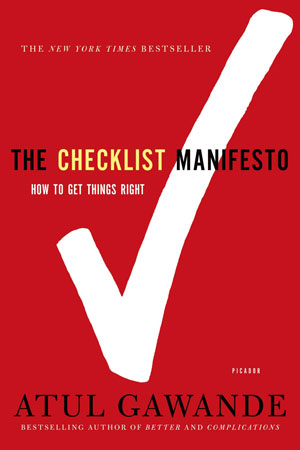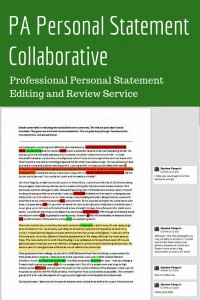The Checklist Manifesto: How to Get Things Right in a World of Increasing Complexity

We live in an era of gratuitous inventions and negative improvements.
Consider the DaVinci Robo surgeon, for example, a drool-inducing twenty-second-century $1.7 million remote-controlled machine designed to help surgeons do laparoscopic surgery with more maneuverability inside patients’ bodies and fewer complications.
- Total cost: 2 million dollars per unit
- Lives and erections saved (for prostatic surgery): none
- Healthcare costs: ten times that of traditional laparoscopic surgery
Nonetheless, hospitals in the United States performed 400,000 robotic surgeries last year and have spent billions of dollars on these machines.
The knowledge, technology, and resources exist. But however supremely specialized, digitized and trained we may have become, steps are still missed.
Mistakes are still made.
A study by researchers at Johns Hopkins Medicine says medical errors should rank as the third leading cause of death in the United States
The Johns Hopkins study estimates that more than 250,000 Americans die each year from medical errors. On the CDC's official list, that would rank just behind heart disease and cancer, which each took about 600,000 lives in 2014, and in front of respiratory disease, which caused about 150,000 deaths.
When it comes to surgery the statistics are just as startling—Americans today undergo an average of seven operations in their lifetime, with surgeons performing more than fifty million operations annually—the amount of harm remains substantial.
There are upwards of 150,000 deaths following surgery every year—more than three times the number of road traffic fatalities. Moreover, research has consistently shown that at least half our deaths and major complications are avoidable.
What is the source of our greatest difficulties and stresses in medicine?
Here, then, is our situation at the start of the twenty-first century:
We have accumulated stupendous know-how. We have put it in the hands of some of the most highly trained, highly skilled, and hardworking people in our society. And, with it, they have indeed accomplished extraordinary things.
Nonetheless, that know-how is often unmanageable. Avoidable failures are common and persistent, not to mention demoralizing and frustrating, across many fields—from medicine to finance, business to government.
And the reason is increasingly evident: the volume and complexity of what we know have exceeded our individual ability to deliver its benefits correctly, safely, or reliably.
Knowledge and technology have both saved us and burdened us.
That means we need a different strategy for overcoming failure, one that builds on experience and takes advantage of the knowledge people have but somehow also makes up for our inevitable human inadequacies.
And in his book Atul Gawande gives us such a strategy—it's almost ridiculous in its simplicity, maybe even crazy to those of us who have spent years carefully developing ever more advanced skills, attending endless conferences and paying big bucks for the latest technologies and "lifesaving" iPhone apps.
It is a Checklist ✅
In 2001, a critical care specialist at Johns Hopkins Hospital named Peter Pronovost decided to give a doctor checklist a try. He didn’t attempt to make the checklist encompass everything ICU teams might need to do in a day. He designed it to tackle just one of their hundreds of potential tasks: central line infections.
On a sheet of plain paper, he plotted out the steps to take in order to avoid infections when putting in a central line. Providers are supposed to:
- Wash their hands with soap.
- Clean the patient’s skin with chlorhexidine antiseptic.
- Put sterile drapes over the entire patient.
- Wear a mask, hat, sterile gown, and gloves.
- Put a sterile dressing over the insertion site once the line is in.
Check, check, check, check, and check.
These steps are no-brainers; they have been known and taught for years. So it seemed silly to make a checklist for something so obvious.
"For a year afterward, Pronovost and his colleagues monitored what happened. The results were so dramatic that they weren’t sure whether to believe them: the ten-day line infection rate went from 11 percent to zero. So they followed patients for fifteen more months. Only two line infections occurred during the entire period. They calculated that, in this one hospital, the checklist had prevented forty-three infections, eight deaths and saved two million dollars in costs."
Pronovost recruited more colleagues, and they tested some more checklists in his Johns Hopkins ICU. One aimed to ensure that nurses observed patients for pain at least once every four hours and provided timely pain medication. This reduced from 41 percent to 3 percent the likelihood of a patient’s enduring untreated pain.
They tested a checklist for patients on mechanical ventilation, making sure, for instance, that doctors prescribed antacid medication to prevent stomach ulcers and that the head of each patient’s bed was propped up at least thirty degrees to stop oral secretions from going into the windpipe. The proportion of patients not receiving the recommended care dropped from 70 percent to 4 percent, the occurrence of pneumonias fell by a quarter, and twenty-one fewer patients died than in the previous year.
The researchers found that simply having the doctors and nurses in the ICU create their own checklists for what they thought should be done each day improved the consistency of care to the point that the average length of patient stay in intensive care dropped by half.
These checklists accomplished what checklists elsewhere have done, Pronovost observed. They helped with memory recall and clearly set out the minimum necessary steps in a process.
Checklists, he found, established a higher standard of baseline performance.
The solution is simple but overcoming resistance is hard
- But will we do it?
- Are we ready to grab onto the idea?
"If someone discovered a new drug that could cut down surgical complications with anything remotely like the effectiveness of the checklist, we would have television ads with minor celebrities extolling its virtues. Detail men would offer free lunches to get doctors to make it part of their practice. Government programs would research it. Competitors would jump in to make newer and better versions. If the checklist were a medical device, we would have surgeons clamoring for it, lining up at display booths at surgical conferences to give it a try, hounding their hospital administrators to get one for them—because, damn it, doesn’t providing good care matter to those pencil pushers?"
The Checklist Revolution
Just making the right treatment choice among the many options for a heart attack patient can be difficult, even for expert clinicians. Furthermore, whatever the chosen treatment, each involves abundant complexities and pitfalls.
In my perfect world, a patient wouldn't be able to exit the office room door without the electronic medical record (EMR) running a simple checklist.
Medical care for common disorders like diabetes and pneumonia has been shown to meet national guidelines only slightly more than half the time.
Does your patient have diabetes? Yes - then run the checklist:
- AIC ✅
- Vision screen ✅
- Blood pressure at goal ✅
- Annual foot exam ✅
- Pneumococcal and flu vaccines ✅ and ✅
- Any medicine interactions? ✅
- Next visit scheduled? ✅
- Email and automatic text sent to the patient? ✅ Mate!
This would be a computer generated checklist set to run automatically. It would be linked with a patient's digital EMR available at all times to all providers all around the world and viewable via an online portal and handheld application providing sensor readings to doctors and patients alike. If a check was missing it would alert the patient as well as the patient's healthcare team so that the appropriate steps could be taken. And while the computer is making its list it will have cross-referenced 1000's of the most recent medical studies to come up with a list of recommended treatment plans to be implemented.
Computers handle complexity well, better than humans. This can free up physician assistants to do what we do best, be human.
** Of note, in the age of artificial intelligence this will also be our best job security.
The Checklist Manifesto - Even when we know what works, we don’t always know when to apply it.
The Checklist Manifesto is an essential primer on complexity in medicine.
It also provides the framework for a solution, but one that will only work if we take the time to implement it.
Failures of ignorance we can forgive. If the knowledge of the best thing to do in a given situation does not exist, we are happy to have people simply make their best effort. But if the knowledge exists and is not applied correctly, it is difficult not to be infuriated.
For those of us who do the work, however—for those of us who care for the patients and respond when the need calls—the judgment feels like it ignores how extremely difficult the job is. Every day there is more and more to manage and get right and learn. And defeat under conditions of complexity occurs far more often despite great effort rather than from a lack of it.
The Checklist Manifesto offers a practical and simple solution to help manage this complexity. For pre-physician assistants or those outside of the field of medicine, The Checklist Manifesto can help you navigate the complexity of other complex tasks such as applying to PA school or
Artificial intelligence (not discussed in the book) makes the checklist and the algorithms on which it is based even more exciting. Simplicity, built upon complexity, is elegance!
Although I could have used a bit more tips on implementation and organization (for that I will refer you to this book) the Checklist Manifesto is a worthwhile read. Just be warned your days in clinical practice may never be the same again. And for this, we need some ✅'s and balances.
Here are some checklists you can implement today
[genesis_column size="one-third" position="first"]
[/genesis_column]
[genesis_column size="one-third"]
[/genesis_column]
[genesis_column size="one-third"]
[/genesis_column]



















Hey Stephen, The Checklist Manifesto is a good book. I read it a while back and remember how Atul went to the construction company would get the job done right the first time. I liked a lot of his examples in the Air Force too. You did a good job noting all his stats too. However, to me, this really emphasizes the need for cross-discipline management. I tend to think that if HR recruitment diversified their approach to who is managing and administrating hospitals, the costs would change dramatically. Keep up the great work here. Very thoughtful post!